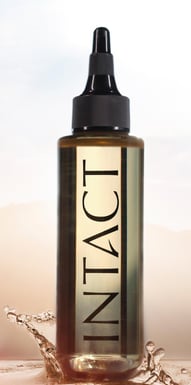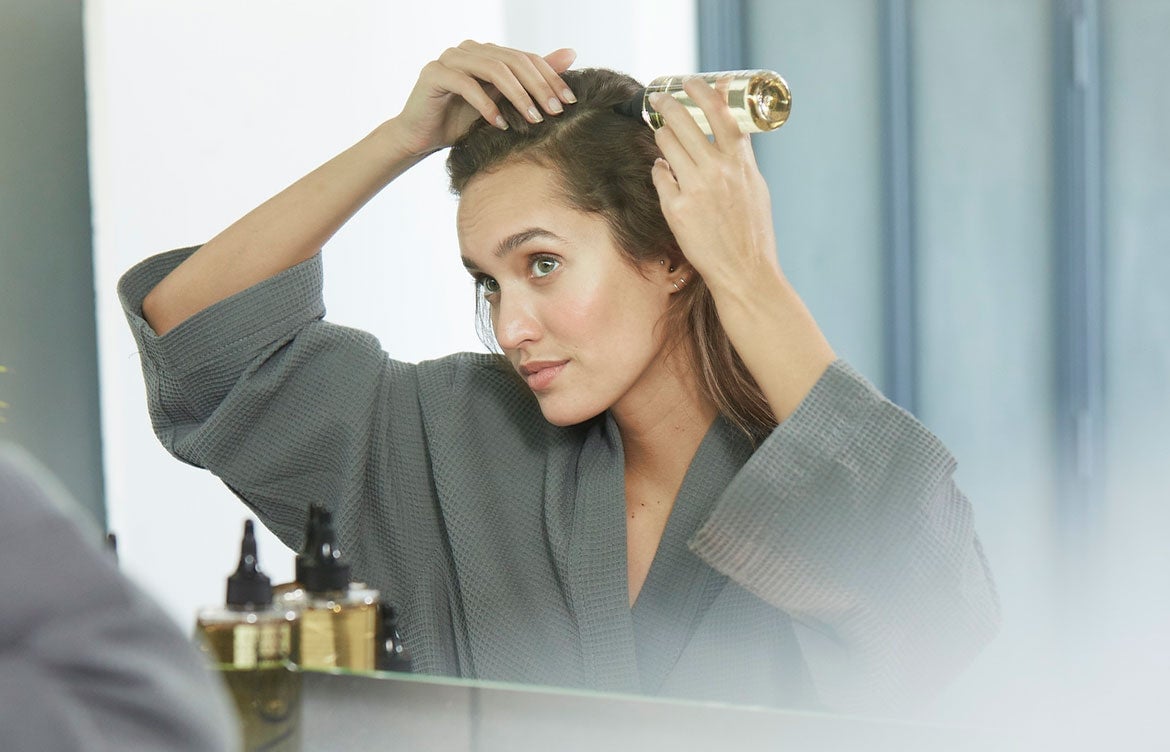Hair Shedding | Hair Loss | Maintenance&Styling
How to Repair Damaged Hair - Best Ways to Treat & Fix Hair Damage

How to Repair Hair Damage
Having healthy hair is an important part of our well-being. But if your hair has started to break, dry out, and lose its shine, you might be dealing with hair damage, and it can be a difficult battle to fight. Not only is styling your hair more difficult, but hair damage causes issues for the scalp, inviting bacteria and skin problems, along with damage to your self-esteem.
If you’re struggling to manage damaged hair, know that it can and will get better. There are plenty of steps you can take, and that’s why we’re here, to help you reclaim control over your hair so you can get back to loving it.
Hair damage tends to accumulate over time, so knowing the signs can help you be proactive about prevention.
So, what are the tell-tale signs of hair damage?
- Split ends
- Uneven surface along hair shaft
- Excessive tangling or frizz
- Thinning or shedding, especially around the hairline or in patches
- Hair snaps instead of stretches when pulled
- Dryness that doesn’t go away after conditioning
- Dull or lackluster appearance
Each of these symptoms may have a number of causes. Before breaking down the best way to repair hair damage, let’s discuss the causes and triggers that might stress out your strands.
What Causes Hair Damage?
Hair damage happens when hairs distort and become fragile, unhealthy, and prone to breaking or falling out. There are many types of hair damage, but it usually presents as:
- Dry, weak hair prone to breakage
- Tangled, lackluster hair that frizzes often
- Thin hair that falls out, especially in patches or near the hairline
What gives? Hair damage is rooted in hair structure anatomy. When the cuticle is lifted, the cortex weakens, or the follicle clogs with gunk, hair damage can occur. Not surprisingly, daily habits often lead to one or more of these issues, which we’ll explore next.
How Washing Damages Your Hair
Keeping your hair clean is essential for preserving its structure and preventing oil build-up. However, washing your hair with the wrong products or frequency can be an issue.
When you wash your hair too often or spread shampoo down the entire hair shaft, it can become frizzy and unmanageable. Overwashing your hair robs the follicles of nourishing nutrients, resulting in fragile, dry hair. Using the wrong shampoo for your hair type can have similar effects, making your hair more brittle and dull.
That’s why it’s vital to learn how to wash your hair properly.
How Styling Damages Your Hair
Heat tools and permanent hair styling techniques offer the chance to flirt with new styles and switch up your look. Who doesn’t love variety? I hear you on that, but excessive heat and chemical treatments can do a number on your hair.
Heat tools can burn hair, drying and weakening it by breaking down the hydrogen bonds that help keep hair strong and healthy. The hair cuticle can become dry or break off, which leads to split ends and breakage. And sadly, the more often you use heat tools, the worse it can get.
The same goes for permanent hairstyling techniques like perms or relaxers, which carry the damaging effects of heat and introduce chemicals into the equation. The process involves alkaline chemicals that can cause splitting, cracking and breakage. The chemicals and heat mingling together make the hair more porous, meaning the shaft swells and dries out. A dry, swollen hair shaft allows harmful substances into the cuticle, damaging the hair at the root.
As damaging as styling can be, who wants to give up their signature look? In a bit, we’ll share how you can maintain style without compromising your locks.
How the Sun Damages Your Hair
The sun gives us plenty of health benefits, nourishing our body with restorative Vitamin D. However, UV rays are not so generous. According to a 2015 study, UV rays can make hair weaker, rougher, and duller. The extent of the damage comes down to hair color.
First, a quick hair lesson. Our natural hair color comes from a pigment called melanin. There are two types of melanin: eumelanin, which creates brown and black hair, and pheomelanin, which creates blond and red hair. UV rays lead to bleaching for all hair colors, but pheomelanin is more sensitive to the damage than eumelanin.
Bottom line: if you have lighter hair, you’ll need to take extra precautions to avoid sun damage.
How Hair Dye & Bleach Damages Your Hair
Bleaching or dyeing hair is a permanent alteration that changes the hair’s chemical structure. Bleach does this by opening the cuticle, then oxidizing melanin inside the cortex with a lightening agent like hydrogen peroxide to remove the color. The process involves lifting the cuticle and reducing hair-strengthening fatty acids.
Permanent hair dye mostly follows the same process. Instead of leaving the hair without color, the dye introduces a new color within the cortex. If you use a developer, the damage is about the same as bleaching.
These two processes result in distorted hair shafts, breakage, and splitting. The hair is left with fewer proteins and less protection — both undesirable effects.
How Stress Damages Your Hair
We all know stress is bad for our health, but did you know stress can cause hair loss?
In a 2021 Harvard study, researchers found that stress hormones stopped the dermal papillae from releasing a molecule that activates stem cells in the hair follicle. In other words, intense stress made the hair stop its growth process. Although these experiments were conducted on rats, researchers believe the findings could explain why stress and hair loss are often intertwined for humans.
Women have it even worse, as they’re almost twice as likely as men to suffer anxiety disorders, according to a 2016 systematic review.
Sadly, we can’t eliminate all stress from our lives, but we can incorporate strategies to help manage it. You can minimize stress by meditating, keeping up with loved ones, and talking to a therapist if necessary. Something as simple as taking a lunchtime stroll outside and basking in the fresh air can invite stress relief.
How Certain Hairstyles Damage Your Hair
We’ve all been there, swatting away rogue strands falling in front of our face. But keep in mind that some updos are damaging. The biggest culprit is tension: tight braids, buns, and ponytails. Cornrows, dreadlocks, and hair extensions are equally risky. These styles can make your hair fall out from traction and pulling and can result in traction alopecia.
Traction alopecia is a form of hair loss caused by hair being repeatedly tugged. Most women who suffer from traction alopecia wear their hair back in tight hairstyles daily. These hairdos make the hair shaft loosen bit by bit in the follicle. It’s like slowly yanking your hair out over time. However, if you catch it early on, you can repair damaged hair and reverse traction alopecia.
As you can see, many lifestyle factors can disrupt the health of your hair. So, let’s talk about the best hair damage solutions to help you take control and get your hair back on the rails to full recovery.
How to Prevent Hair Damage
You can’t fix damaged hair overnight, as lovely as that would be. The process involves making small changes and sticking to them. The best way to fix hair damage? Prevent it from happening. Ensuring your scalp is clean, moisturized, and protein-rich can prevent shedding, breakage, and split ends.
It may come as no surprise, then, that the best treatment for damaged hair starts with our hair care routines. Read on for solutions you can start using now.
Use The Right Shampoo
Over-washing or using the wrong shampoo can strip the natural oils from your hair, leading to breakage and frizz. So, what’s a girl to do?
First, find the right shampoo for your hair type:
- Dry hair: Mild shampoos or shampoos with conditioning agents
- Oily hair: Higher-intensity cleansing shampoo that isn’t tailored toward moisturizing
- Fine and thin hair: Lightweight, clear or translucent shampoos will help build volume, while ingredients like amino acids and biotin strengthen your strands.
Take the following steps to prevent hair damage before it happens:
- Choose pH-balanced shampoos, typically containing an acidic adjuster like glycolic acid, to keep the cuticle and shaft protected.
- If your hair is chemically treated, choose a shampoo with a neutral pH.
- If you wash your hair often, use a shampoo that includes a conditioner or a conditioning vitamin like vitamin B5.
Use Conditioner
Conditioner provides protection and strength to keep our hair healthy until the next wash. Using a good conditioner will hydrate your hair and prevent breakage. Conditioner will also give your hair the strength to fight against daily hair damage aggressors.
The best way to fix hair damage with conditioner is to check the ingredients. Plant oils can help repair damaged hair, while proteins and amino acids can help strengthen the cuticle and protect it from heat damage. If you have dry hair, look for silicone ingredients (ending in “-icone”) for an added moisture boost.
Keep Your Hair Moisturized
Despite being told to wash your hair every day, over-washing can be highly damaging. To ensure your hair stays hydrated and protected, it’s crucial to keep your hair moisturized between washes.
If you tend to lose moisture throughout the day, spritz on a hydrating oil or moisturizing hair mist a few times a day. You can even spray a bit of water to rehydrate your locks. If you have to wash your hair daily, use a moisturizing hair mask or a leave-in conditioner once a week.
To avoid losing moisture, opt for a silk pillowcase over cotton and load up on water to stay hydrated.
Maintain a Balanced Diet
Hair relies on proteins and minerals to maintain its growth cycle. According to a 2017 literature review, protein and biotin deficiency can lead to hair loss. The study also concludes that antioxidants like zinc and Vitamin C can prevent oxidative damage, ultimately preventing hair loss due to oxidative stress.
Getting enough keratin (the protein our hair is made of) is also crucial to hair health. Incorporating keratin and other proteins into your diet can repair damaged hair from chemical processes and make it stronger.
Wear a Sun Hat
When the sun is at its peak, we all flock to the outdoors. Who can resist a bright, sunny day? Well, all that exposure can lead to significant hair fall. In fact, concerns about hair loss typically peak during summertime, when the sun has more access to our precious locks.
Fortunately, there’s a simple solution!
Wearing a sun hat can prevent hair damage by creating a shield from UV rays. Plus, there is no shortage of stylish sun hats. If you can’t wear a hat, spritz on a hair mist or leave in a product with protective ingredients like fatty acids, plant oils, and antioxidants. When you’re applying sunscreen, be sure to apply it on your scalp as well.
Avoid Chemical Dyes
The harm caused by bleaches and dyes can last some time, so avoiding chemical hair treatments is the best preventative hair damage solution. However, you can still bleach or dye your hair while reducing the level of damage.
Instead of using dyes with harsh chemicals like ammonia or peroxide, look for ones with higher amounts of natural ingredients like botanicals and plant oils. Adding a regular hair mask or leave-in conditioner to your routine will allow treated hair to keep some of its original structure and moisture.
A few more tips for minimizing chemical damage:
- Opt for semi-permanent dyes.
- Wash your hair 24 hours before bleaching to allow natural oils to build a protective layer.
- Coat your ends with hair serum before applying a hair mask.
Avoid Hot Styling Tools
Earlier, I explained the consequences of repeated exposure to heating tools. So what can you do about it? Cutting heat styling out of your routine will do wonders for your hair’s longevity, but it’s not always practical. To replace this habit, you can opt for letting your hair air-dry or blow-drying your hair on the cold setting.
Refraining from styling with heat tools is the best way to repair hair damage, but it’s not always realistic. There are plenty of ways to protect your hair without tossing out all your curling irons:
- Prep your hair with a heat protectant before using heat tools
- Apply a nutrient-rich oil to your hair after heat styling
- Use the lowest heat setting you can and avoid going over the same section of hair more than once
Avoid Tight Hairstyles
Avoiding tight hairstyles can keep your cuticles intact and prevent hair loss. You can still keep your hair out of your face while keeping it healthy by opting for looser styles. Soft hair ties like scrunchies and scarves can prevent hair from tangling and falling out. When removing the hair tie, take your time untying it to avoid yanking out hair.
Diversifying your ‘do can help repair hair damage, too. Low ponytails, half-up styles, and loose braids can prevent targeted breakage. Plus, mixing up your styling day-to-day will not only give your follicles relief but also keep your routine fun and look fresh!
Now that you know the tips and tricks to fix hair damage, it’s time to introduce the best hair repair treatment for damaged hair: INTACT.
INTACT Anti Hair Shedding Treatment

INTACT is the best product on the market to control hair damage. Hair fall and shedding is a major part of hair damage, and INTACT is here to stop it in its tracks. No matter what type of hair or hair damage you have, INTACT will transform your hair routine.
INTACT carries a multitude of benefits for your hair and scalp. Not only does INTACT provide volume and shine, but it also minimizes breakage and secures hair at the root for maximum strength.
The treatment has a results-driven track record for success. The product is a clinically proven, dermatologist-developed formula that can diminish hair loss by up to 77%, securing its spot as the best hair treatment for damaged hair.
The science behind INTACT is what makes it so effective at reducing hair damage.
How Does INTACT Work?
INTACT works by securing hair at the root with Sevilla Orange extract and keeping hair moisturized and hydrated with coconut fatty acids. Sevilla Orange extract activates a muscle in the hair follicle that causes it to contract, locking the hair in place to protect it from being pulled out.
How do you use INTACT? It’s simple! Just massage the product into your scalp half an hour before washing, and you’re guaranteed to see results after just one use. If that isn’t impressive enough, INTACT is the one and only product that can strengthen and secure hair at the root.
Take the guesswork out of your hair product search and try the best treatment for damaged hair: INTACT. Once you see the results, you’ll never look back — except to do a fabulous hair flip!
Start Protecting Your Hair Today!
 When it comes to damaged hair treatment, every strand counts. The best way to fix hair damage is to be proactive about strengthening and protecting your hair. If you’re looking for the best hair protection out there, learn more about how INTACT can take your hair from drab to fab!
When it comes to damaged hair treatment, every strand counts. The best way to fix hair damage is to be proactive about strengthening and protecting your hair. If you’re looking for the best hair protection out there, learn more about how INTACT can take your hair from drab to fab!

